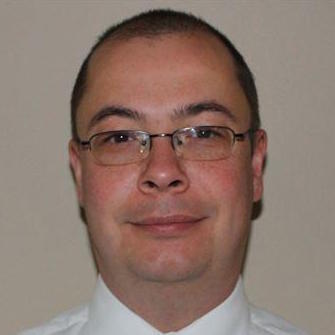Artificial intelligence (AI) can be used to reduce the number of biopsies of benign thyroid nodules, according to new research from University of Colorado Cancer Center member Nikita Pozdeyev, MD.
“Thyroid nodules are very common. If you look at the thyroids of female patients above 60 years old, more than half of them will have some abnormalities on ultrasound,” says Pozdeyev, an assistant professor of biomedical informatics in the CU School of Medicine. “In our endocrine practice, it's a very common task to review thyroid ultrasound findings and decide which nodules are potentially cancerous and need to be biopsied, and which nodules are likely to be benign and can be watched.”
But only 5% to 15% of biopsied nodules turn out to be cancerous, Pozdeyev says. That’s why, when he worked at the University of Washington, he started looking for a more accurate way to determine which nodules are unlikely to be cancerous and do not need a biopsy. He began to investigate the effectiveness of machine learning on the problem, building an artificial neural network to analyze thousands of ultrasound images of thyroid nodules, both cancerous and benign, and learn their visual characteristics. Once the computer finished its learning cycle, it was able to examine new ultrasound images and determine if they are likely to be cancerous or benign. AI identified that some nodules have such a low risk of being cancerous that observation can be used instead of proceeding with invasive biopsy.
“You need to train it well, but once it works, it works,” Pozdeyev says of the AI program. “It doesn't have the flexibility that human providers have, where we can recognize special cases; it only does what it's trained for. But it does it well, and it does it consistently.”
High success rate
Pozdeyev used 30,000 images from 621 thyroid nodules to train the machine-learning model that classifies thyroid nodules as “cancer” or “no cancer.” The AI-based model achieved a sensitivity (ability to not miss cancer) of 97%, and a specificity (ability to correctly identify a cancer) of 61%.
“This study demonstrates that the ultrasound-based AI classifier of thyroid nodules achieves sensitivity comparable to that of thyroid biopsy with fine needle aspiration,” says Pozdeyev, who presented his research in June at the Endocrine Society’s ENDO 2022 thyroid health news conference.
Issues of cost, expertise, convenience
A reduction in unnecessary biopsies, Pozdeyev says, means a reduction in a procedure that, while it isn’t usually dangerous, can be inconvenient, uncomfortable, and expensive for patients. There is no standard screening for thyroid cancer, so in most patients the tumors are discovered incidentally — say during a CT scan after a car accident looking for a neck injury. The patient is sent first for an ultrasound, then to a radiologist or endocrinologist for the biopsy, which is performed as an outpatient procedure.
“In the United States, we do roughly about half a million of these procedures each year,” he says. “The problem is that the interpretation of the ultrasound is operator-dependent. It requires skill. Highly trained radiologists or endocrinologists will recognize benign or suspicious features on the ultrasound very well, but that's not always the case in the community, where suspicious features get overemphasized. So we end up doing a lot more fine-needle aspiration biopsies.”
Clinical trials and further modifications
Going forward, Pozdeyev plans to develop a clinical trial to compare the results of the machine-learning program to those of the biopsies, to confirm the two methods are equivalent in ruling out cancer in a subset of thyroid nodules. The next step would be to build a user-friendly interface of his program, accessible either locally or online, so that technicians with no specialized machine-learning training could simply upload images from an ultrasound and get the results. He is also looking at the possibility of adding genetic risk information , so that the computer system can take into account the inherited risk of developing thyroid cancer.
“The tool also has to be generalizable, meaning it will work in different settings, not just at the University of Colorado,” he says. “Then everybody can use it to decide which nodules need to be watched instead of biopsied. None of my patients are excited about getting needles put in their neck, and there is a significant cost associated with doing this. We don’t need to diagnose benign disease using an invasive procedure.”
→ Learn more about the new biomedical informatics department at the CU School of Medicine.




.png)